Eff ects of vitamin C defi ciency or excess on growth performance, anti-oxidative response and fatty acid composition of juvenile abalone Haliotis discu s hannai Ino*
LI Xinxin , , FENG Xiuni , , LUO Kai , MA Shuoli , DENG Junming , ZHANG Wenbing , , MAI Kangsen
1 Key Laboratory of Mariculture (Ministry of Education), Key Laboratory of Aquaculture Nutrition and Feeds (Ministry of Agriculture), Fisheries College, Ocean University of China, Qingdao 266003, China
2 Jiaozhou Fisheries Technology Promotion Station, Qingdao 266003, China
3 College of Animal Science and Technology, Yunnan Agricultural University, Kunming 650201, China
Abstract A 240-day feeding trial was conducted to investigate the eff ects of dietary vitamin C on growth performance, anti-oxidative response, and fatty acid composition of juvenile abalone Haliotis discus hannai Ino (initial body weight: 0.93±0.00 g). Three semi-purifi ed experimental diets were formulated containing 0.00, 94.52, and 9 649.58 mg/kg of vitamin C supplied as L-ascorbyl-2-monophosphate. The results show that there was no signifi cant diff erence in weight gain ratio, daily increment in shell length, and survival rate among the three treatments. Adding dietary vitamin C (9 649.58 mg/kg) signifi cantly increased the activities of superoxide dismutase (SOD), glutathine peroxidase (GPX), glitathione-S-transferase (GST), glutathione reductase (GR), alkaline phosphatase (AKP), and lysozyme in viscera ( P <0.05). In muscle, activities of phenoloxidase, catalase, SOD, GST, GR, and AKP were increased in the treatment with 9 649.58 mg/kg of dietary vitamin C ( P <0.05). The highest concentrations of ascorbic acid in viscera and muscle were found in the group with 9 649.58 mg/kg of dietary vitamin C ( P <0.05). The contents of crude protein and crude lipid in the soft body were signifi cantly increased in the 9 649.58 mg/kg group ( P <0.05). Dietary vitamin C supplementation signifi cantly decreased the contents of saturated fatty acids (14:0, 16:0, and 18:0), and increased the composition of 18:2n-6 and 22:6n-3 in the soft body of abalone ( P <0.05). Therefore, although there were no signifi cant eff ects on the growth performance, dietary vitamin C supplementation improved the anti-oxidation and immune responses, increased specifi c unsaturated fatty acid (i.e., 16:1, 18:1n-7, 18:1n-9, 18:2n-6 and 22:6n-3), and decreased specifi c saturated fatty acid (i.e., 14:0, 16:0 and 18:0) contents in the soft body of abalone.
Keyword: abalone; ascorbic acid; anti-oxidative capability; fatty acid
1 INTRODUCTION
Vitamin C, also known as ascorbic acid, is a watersoluble vitamin that involves many physiological processes including growth, collagen formation, iron metabolism and haematology, reproduction, and wound healing (NRC, 2011). It can also scavenge harmful free radicals produced by cells (Bendich et al., 1986; Ames et al., 1993; Shao et al., 2018), and inhibit the destructive eff ect of reactive oxygen species (ROS) on biological macromolecules (Berger et al., 1997) to protect cells from oxidative damage (Halver, 1995; Chew, 1996). In addition, numerous studies have shown that vitamin C could improve the innate immunity in many ways, such as protecting surrounding phagocyte and promoting serum bactericidal activity (Ren et al., 2008; Chen et al., 2015). In aquatic animals, vitamin C can improve the anti-oxidative ability and innate immunity of fi sh and shrimp, such as Wuchang breamMegalobramaamblycephalaYih (Ming et al., 2012), cobiaRachycentroncanadum(Zhou et al., 2012), loachMisgurnusanguillicaudatusCantor (Zhao et al., 2017) and white shrimpLitopenaeusvannamei(Lόpez et al., 2003; Wu et al., 2016).
Vitamin C activates the lipid soluble system and protects lipid membranes from free radical peroxidation (Kosutarak et al., 1995; Hwang and Lin, 2002; Wang and Huang, 2015). In aquatic animals, researches have shown that dietary vitamin C increased the lipid contents in yellow drumNibeaalbifl ora(Wang et al., 2017), and eff ectively prevented the lipid peroxidation in common carp (Hwang and Lin, 2002). Moreover, Gao et al. (2013) observed that incremental dietary vitamin C increased percentages of EPA, DHA, 22:5n-3, and total n-3 fatty acids in both liver and muscle of red sea breamPagrusmajor. On the contrary, the percentages of 14:0, 18:0, and 18:1n-9 decreased with increased dietary vitamin C levels.
Abalone of the archaeogastropod genus of mollusca is one of the most important mariculture mollusk species in China, with more than 148 539 tons produced in 2017 (Fishery Bureau, Ministry of Agriculture, People’s Republic of China, 2018). Among the abalone farmed in China,HaliotisdiscushannaiIno is the most important species. A previous study showed that supplementation of vitamin C from 0 to 800 mg/g in diet had no signifi cant eff ects on the growth of juvenile abalone, but signifi cantly aff ected the accumulation of ascorbic acid in the soft body (Mai, 1998). The purpose of the present study was to explore the eff ect of dietary vitamin C defi ciency or excess on growth performance, anti-oxidative response and fatty acid composition of juvenile abalone. It provides basic data to better understand the protective eff ects of vitamin C on abalone.
2 MATERIAL AND METHOD
2.1 Experimental diets
The basal diet formulation was based on Wu et al. (2010, 2011), and the ingredients are shown in Table 1. The basal diet contained 306.8 g/kg of crude protein from casein (vitamin free) and gelatin, and 33.2 g/kg of crude lipid from soybean oil and menhaden fi sh oil (1:1). Vitamin C was added to the diets at levels of 0, 100, and 10 000 mg/kg in the form of L-ascorbyl-2-monophosphate, and the corresponding vitamin Ccontents in diets were 0.00, 94.52, and 9 649.58 mg/kg, respectively.
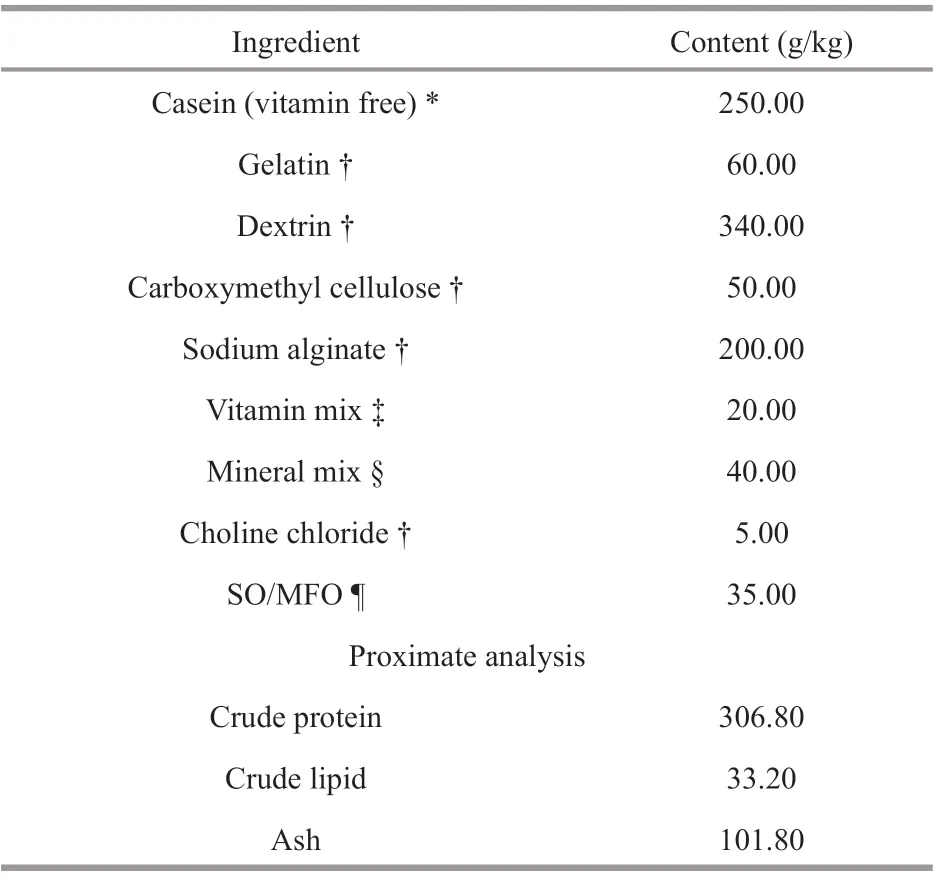
Table 1 Ingredients and compositions of the basal diet
2.2 Experimental animals and feeding trial
Abalone juveniles (initial shell length: 1.74±0.03 cm, initial weight: 0.93±0.00 g) were collected from Damai Island in Qingdao. Before the start of the feeding trial, all abalones were acclimated to the experimental conditions for 14 days with normal diet with no vitamin C supplementation. After body weight was measured, abalones were randomly distributed into nine tanks and 55 individuals per tank. Each treatment had three replicates (tanks). The feeding trial was carried out in an indoor recirculating water system. The pre-weighted experimental diets were fed to abalone once a day (17:00) at a satiation level for 240 days. Feces and excess feeds were removed at 8:00 every morning to maintain water quality. During the feeding trial, water temperature ranged from 17.5–19.0°C, salinity 31–34, pH 7.4–7.9, and dissolved oxygen was above 7 mg/L.
2.3 Leaching
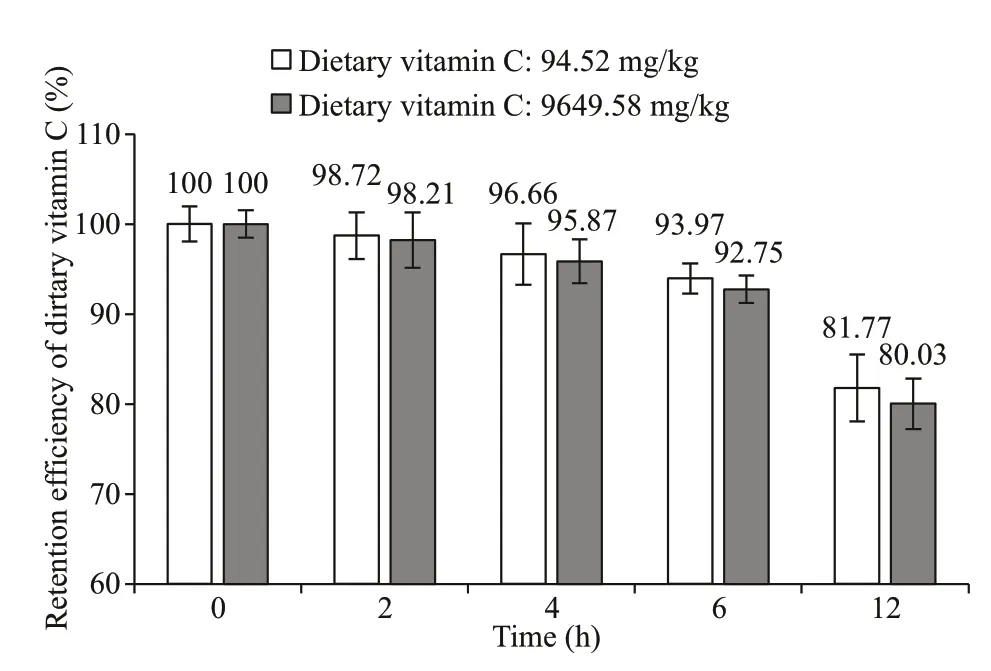
Fig.1 The retention effi ciency of vitamin C in diets at diff erent interval immersed in seawater (0, 2, 4, 6, and 12 h)
The leaching test for dietary vitamin C was carried out according to the method used by Zhang et al. (2003). Pre-weighed diet was placed onto 100-μm mesh screens and allowed it to the bottom of experimental glass aquaria. Temperature was adjusted to match that of the experiment (18±1°C). At allotted time (0, 2, 4, 6, and 12 h, respectively), the remaining diet was removed from the glass aquaria and lyophilized. Dried diet was submitted to analyses of vitamin C contents. The leaching of dietary vitamin C was expressed as retention effi ciency (RE):

whereVtandV0are fi nal (0, 2, 4, 6, or 12 h) and initial dietary vitamin C content, respectively.
2.4 Sample collection and analysis
All animal care and handling procedures were approved by the Animal Care Committee of Ocean University of China. Before sampling, all the abalones were fasted for 3 days. Abalones in the same tank were counted one by one and weighed together. The viscera and muscle were collected and stored at -80°C for later analysis. The crude protein and crude lipid content of diets and soft body of abalone were quantifi ed by the method of AOAC (1995).
2.4.1 Ascorbic acid analysis
The concentrations of ascorbic acid in abalones and diets were determined by high performance liquid chromatography (HPLC, Agilent 1100). The mobile phase was 0.05 mol/L KH2PO4at pH 2.8 and the fl ow rate was 0.6 mL/min. Weighed samples were homogenized in 5% cold metaphosphoric acid, homogenates were centrifuged at 2 739×gfor 6 min, and supernatants were analyzed on HPLC after being fi ltered through a 0.22-μm pore size syringe fi lter. The detection wavelength was 254 nm, column temperature was 30°C, and dissolving appropriate amount of ascorbic acid (Sigma Chemicals Co.) in ultrapure water was used as standard sample.
2.4.2 Activities of enzymes
Activities of acid phosphatase (ACP), alkaline phosphatase (AKP), lysozyme(LZ), phenoloxidase (PO), catalase (CAT), superoxide dismutase (SOD), glutathione peroxidase (GPX), glutathione S-transferase (GST) and glutathione reductase (GR) were determined by the commercial reagent kits (Nanjing Jiancheng Bioengineering Institute) according to the protocol instructions.
2.4.3 Fatty acid analysis
Fatty acid methyl esters (FAMEs) were prepared by esterifi cation using 2% sulfuric acid methanol as described in Metcalfe et al. (1966). The FAMEs were separated and quantifi ed using HP 5890II gas chromatograph (Agilent) equipped with a fused silica capillary column (007-CW). The temperature program was: initial temperature 150°C, 15°C/min rise to 200°C, then 2°C/min rise to 250°C. Nitrogen was used as carrier gas. The fatty acid quantifi cation was identifi ed by comparison of retention time and peak area with standard FAMEs (Sigma Chemicals Co.).
2.5 Calculations and statistical analysis
The growth performances of abalone were expressed as weight gain ratio (WGR), the daily increment in shell length (DISL) and survival rate (SR). They were calculated as follows:

whereWtandWiare fi nal and initial body weight of abalone respectively; SLtand SLiare fi nal and initial shell length (cm) of abalone, respectively;tis feeding trial duration in day;NtandN0are fi nal and initial numbers of abalone in each replicate, respectively.
Statistical analysis was performed using SPSS 25.0 and Microsoft Excel 2010. All the data were presented as means±SE. Data were analyzed by one-way ANOVA. Diff erences between the means were tested by Tukey’s test at level of 0.05.
3 RESULT
3.1 Leaching
The results of the leaching test with experimental diets are illustrated in Fig.1. The retention effi ciency(RE) of dietary 94.52 mg/kg vitamin C at diff erent interval immersed in seawater for 0, 2, 4, 6, and 12 h were 100%, 98.72%, 96.66%, 93.97%, and 81.77%, respectively. In the diet of 9 649.58 mg/kg vitamin C, the RE at diff erent interval immersed in seawater for 0, 2, 4, 6, and 12 h were 100%, 98.21%, 95.87%, 92.75%, and 80.03%, respectively.

Table 2 Eff ects of dietary vitamin C on the growth and survival of abalone Haliotis discus hannai Ino after a 240-day feeding trial

Fig.2 Eff ects of dietary vitamin C on crude lipid (a) and crude protein (b) contents in the soft body of abalone Haliotis discus hannai Ino after a 240-day feeding trial
3.2 Growth performance
The results of the growth performance of abalone are shown in Table 2. There were no signifi cant diff erences in WGR, DISL, and SR among all the groups (P>0.05). The WGR were ranged 201.56%–234.38%, the DISL 42.24–46.90 μm/d, and the SR 69.09%–72.73%.
3.3 Soft body composition
The contents of crude lipid and crude protein in the soft body of abalone are shown in Fig.2. The highest value of crude lipid content was in the group with 9 649.58 mg/kg of dietary vitamin C (P<0.05), but there was no signifi cant diff erence between the other two groups (P>0.05). The signifi cantly lowest value of crude protein was in the group with 0 mg/kg of dietary vitamin C (P<0.05).
The contents of ascorbic acid in the soft body of abalone are shown in Fig.3. Ascorbic acid contents had the highest value in viscera (449.78 μg/g) and muscle (253.33 μg/g) in the group with 9 649.58 mg/kg of dietary vitamin C (P<0.05). There was no signifi cant diff erence between the treatments with 0 mg/kg and 94.52 mg/kg of dietary vitamin C (P>0.05).
3.4 Activities of anti-oxidation and immune related enzymes
The activities of AKP, ACP, LZ, and PO in viscera and muscle are shown in Tables 3 & 4, respectively. The highest value of AKP activity in viscera was found to be 23.67 U/g protein in the 9 649.58 mg/kg group (P<0.05). In muscle, the activity of AKP signifi cantly increased with the increasing of dietary vitamin C levels (P<0.05). However there was no signifi cant diff erence in ACP activity in viscera and muscle among the three treatments (P>0.05).

Fig.3 Eff ects of dietary vitamin C on the contents of ascorbic acid in viscera (a) and muscle (b) of abalone Haliotis discus hannai Ino after a 240-day feeding trial
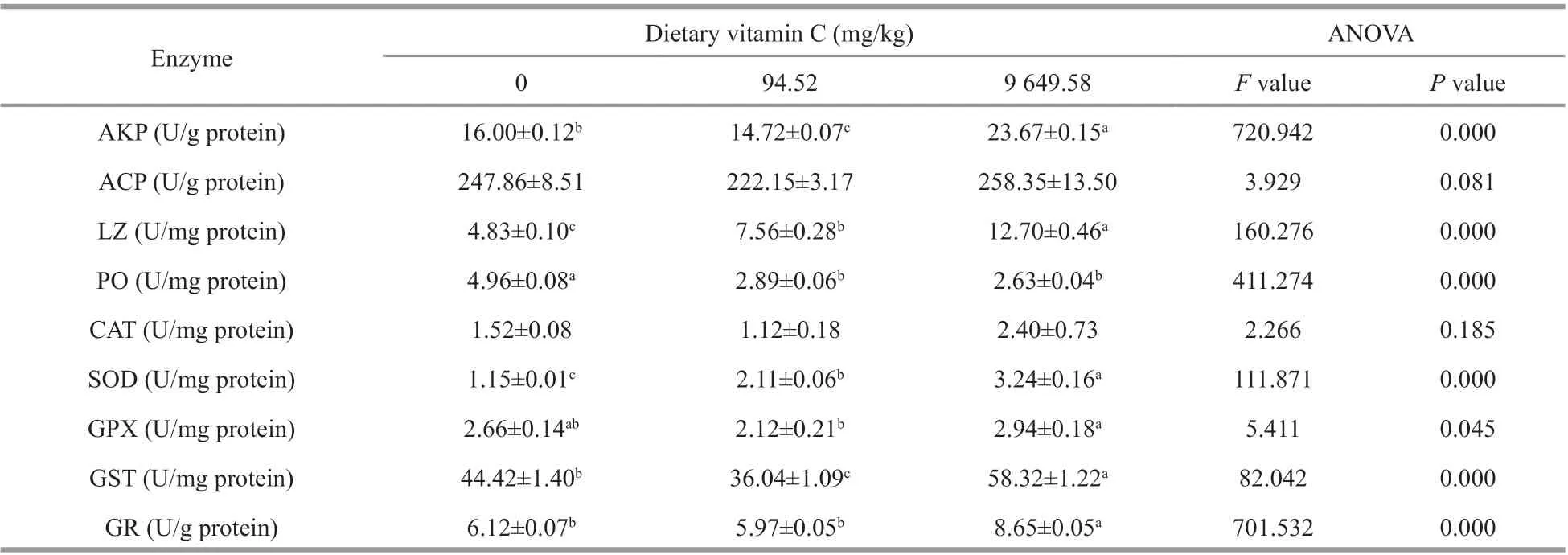
Table 3 Eff ects of dietary vitamin C on the activity of anti-oxidative enzymes and immune parameters in viscera of abalone Haliotis discus hannai Ino after a 240-day feeding trial
With the increasing of dietary vitamin C levels, the activity of LZ in viscera signifi cantly increased (P<0.05). In muscle, there was no signifi cant diff erences in LZ activity among all the groups (P>0.05). The addition of dietary vitamin C (94.52 and 9 649.58 mg/kg) signifi cantly increased the activity of PO in muscle (P<0.05). However, in viscera, the highest value of PO activity was 4.96 U/mg protein in the 0 mg/kg group.
The activities of CAT, SOD, GPX, GST, and GR in viscera and muscle are shown in Tables 3 & 4, respectively. There was no signifi cant diff erence in CAT activity in viscera among the three treatments (P>0.05). Supplementation of dietary vitamin C (94.52 and 9 649.58 mg/kg) signifi cantly increased the activity of CAT in muscle (P<0.05).
With the increasing of dietary vitamin C levels, the activity of SOD signifi cantly increased in viscera (P<0.05). In muscle, the 9 649.58 mg/kg treatment group signifi cantly increased the activity of SOD (P<0.05). There was no signifi cant diff erence between the groups of 0 and 94.52 mg/kg (P>0.05).
The highest value of GPX activity in viscera was 2.94 U/mg protein in 9 649.58 mg/kg group. There was no signifi cant diff erence in GPX activity in muscle among all the groups (P>0.05). The activity of GST in viscera and muscle was signifi cantly higher in the 9 649.58 mg/kg group than those of 0 and 94.52 mg/kg groups (P<0.05). The highest value of GR activity in viscera was 8.65 U/mg protein in the 9 649.58 mg/kg group (P<0.05). In muscle, the activity of GR signifi cantly increased in the 94.52 mg/kg group (P<0.05).
3.5 Fatty acid compositions
The fatty acid compositions in soft body of abalone are shown in Table 5. The addition of dietary vitamin C (groups of 94.52 and 9 649.58 mg/kg) signifi cantly decreased the contents of saturated fatty acid (SFA) 14:0, 16:0, and 18:0 in soft body of abalone (P<0.05).With the increasing of dietary vitamin C levels, the contents of monounsaturated fatty acid (16:1 and 18:1n-9) and PUFA (18:2n-6 and 22:6n-3) were increased in soft body of abalone (P<0.05). There was no signifi cant diff erence in 18:3n-3, 20:4n-6, and 20:5n-3 in soft body of abalone among the three treatment groups (P>0.05).
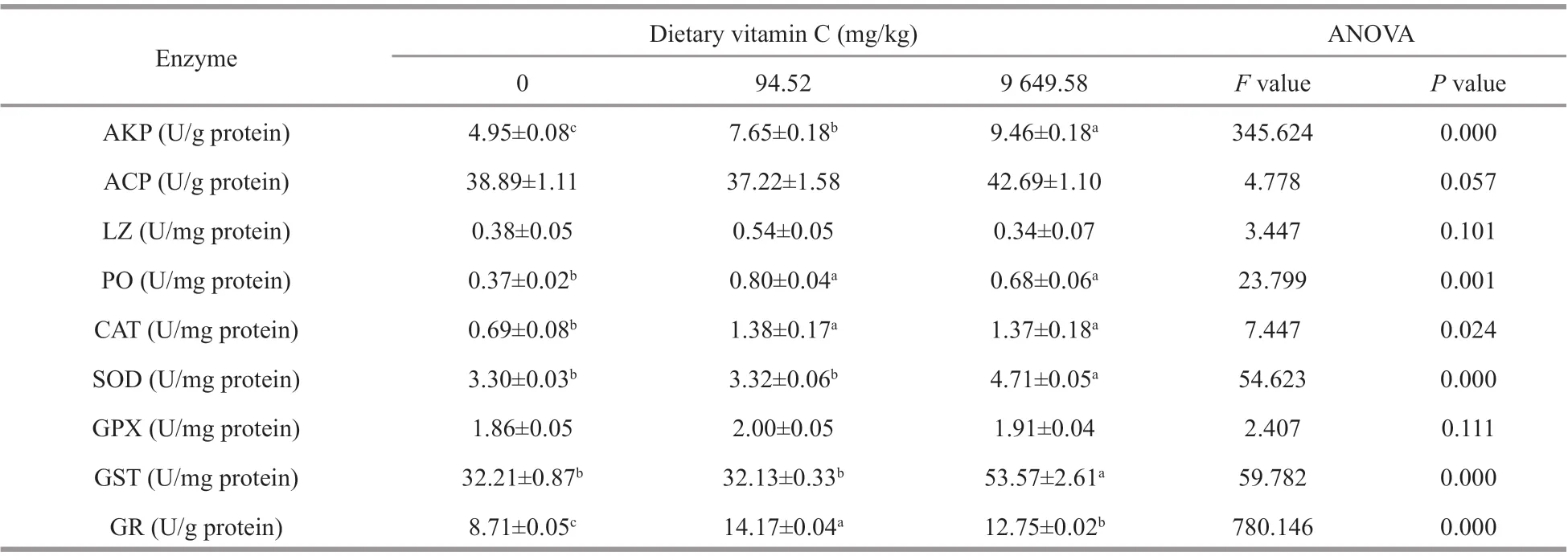
Table 4 Eff ects of dietary vitamin C on the activity of anti-oxidative enzymes and immune parameters in muscle of abalone Haliotis discus hannai Ino after a 240-day feeding trial
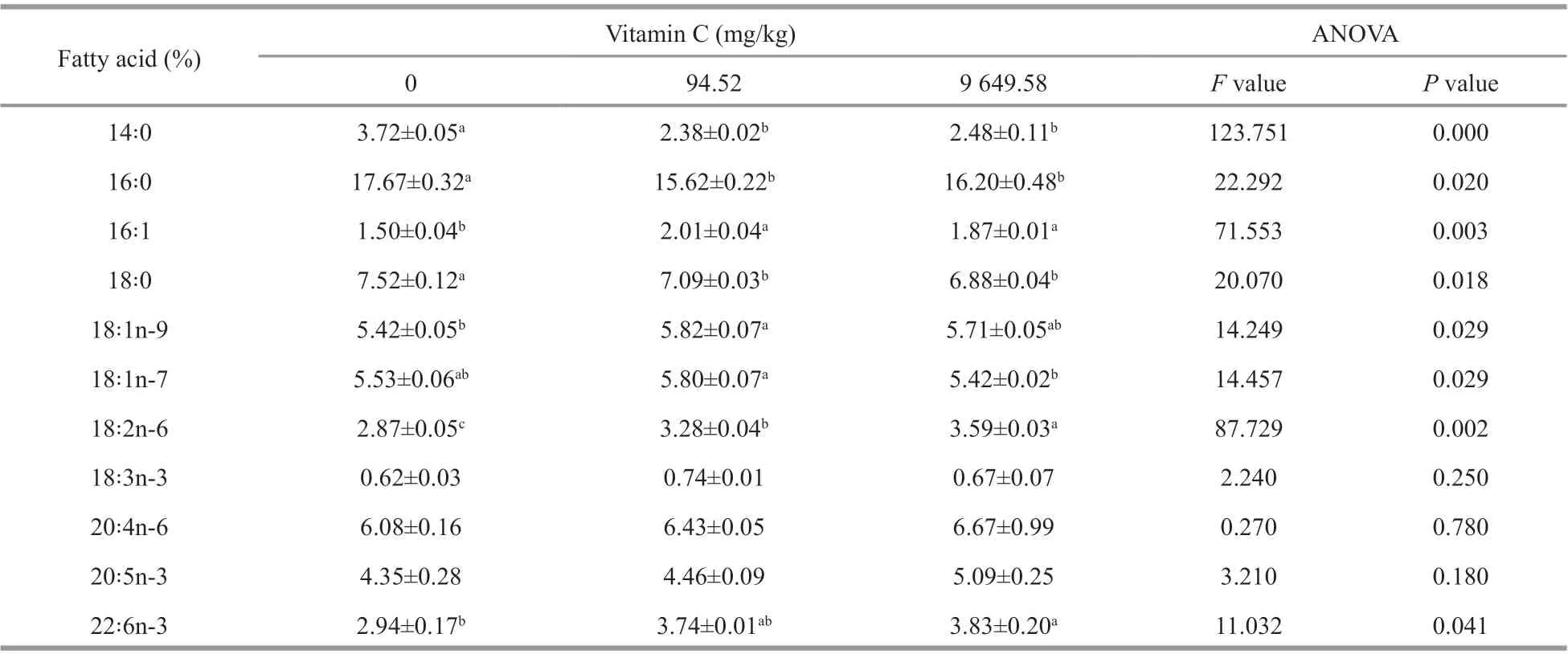
Table 5 Eff ect of dietary vitamin C on fatty acid composition in the soft body of abalone Haliotis discus hannai Ino after a 240-day feeding trial
4 DISCUSSION
As shown in the last section, diff erent levels of dietary vitamin C had no signifi cant eff ects on the growth performance of abalone, which is consistent with a previous study on abalone (Mai, 1998). Dietary vitamin C supplementation signifi cantly increased the content of total lipid in the soft body of abalone (Fig.2), which was consistent with the fi nding in freshwater prawnMacrobrachiummalcolmsoni(Asaikkutti et al., 2016). The possible reason is that vitamin C can activate the lipid soluble system, so that triacylglycerol could decrease and the lipid peroxidation could be prevented (Kosutarak et al., 1995; Wang and Huang, 2015). Moreover, dietary vitamin C supplementation signifi cantly increased the content of crude protein in the soft body of abalone, which is consistent with the fi ndings in Japanese eelAnguillajaponica(Shahkar et al., 2015). Researches showed that high levels of vitamin C could stimulate protein production in fi sh, since diets supplemented with higher vitamin C can increase protein synthesis (Chagas and Val, 2003).
When foreign bodies are phagocytized into cells and fused with lysosome, they are fi nally digested by various hydrolases to decompose (Roosta et al., 2014). The AKP is a hydrolytic enzyme that can enhance the recognition and phagocytosis ability of the invasive organism (Zhou et al., 2012). In present study, the activity of AKP in viscera and muscle reached the maximum value when excessive dietary vitamin C supplemented. In previous studies, dietary vitamin C supplementation could eff ectively increase the serum AKP level in Wuchang breamM.amblycephalaunder pH stress (Wan et al., 2014). Zhou et al. (2012) found that dietary vitamin C supplementation enhanced serum AKP activity in cobiaR.canadum. Our results show that vitamin C could improve the non-specifi c immunity of abalone, and play vital roles in defending the pathogen.
It is generally believed that LZ has bactericidal eff ect and is one of the main defense mechanisms of mollusc (Andersen et al., 1998; Ordás et al., 2000). In present study, dietary vitamin C signifi cantly increased the activity of LZ in viscera, which is consistent with the fi ndings in grass carpCtenopharyngodonidellaand yellow drumN.albifl ora(Xu et al., 2016; Wang et al., 2017). The PO is a key enzyme in the immune system of invertebrates (Gollas-Galván et al., 1997; Moreau et al., 2000). It is closely related to the identifi cation of foreign and host defense. In present study, in the 94.52 mg/kg group, the activity of PO in muscle was signifi cantly increased, which is consistent with the fi ndings in grass shrimpPenaeusmonodonand white shrimpL.vannamei(Lee and Shiau, 2002; Qiao et al., 2011).
The anti-oxidative enzymes, such as CAT, SOD, GPX, and GST, can remove excessive damaging ROS, and reduce the damage by lipid peroxidation. The GR could prevent the oxidative decomposition of hemoglobin, and maintain the activity of mercapto group protein to ensure the integrity of cells (Freeman and Crapo, 1982; Yang and He, 2007; Asaikkutti et al., 2016; Liang et al., 2017). The present results showed that compared with vitamin C defi ciency, dietary vitamin C supplementation signifi cantly increased the activity of anti-oxidative enzymes in viscera and muscle of abalone. Although the activity of enzymes in diff erent tissues was slightly diff erent, the basic trend was identical. These fi ndings were in agreement with those in yellow catfi shPelteobagrusfulvidraco(Liang et al., 2017) and black carpMylopharyngodonpiceus(Hu et al., 2013). These data indicate that vitamin C can enhance the antioxidative ability of abalone. In addition, it is speculated that the high anti-oxidative response are associated with the accumulation of ascorbic acid in abalone. In this study, with the increasing of dietary vitamin C levels, the content of ascorbic acid in the soft body of abalone was also increased, and the antioxidative responses of abalone were improved.
Vitamin C is known aff ecting the fatty acid composition ofTeraponjarbua(Chien and Hwang, 2001). Researches showed that the SFA were represented by C14:0, C16:0, and C18:0. The monounsaturated fatty acid (MUFA) were dominated by C18:1n-7, C18:1n-9, and C20:1n-9 in soft body of abalone (Lou et al., 2013). In this study, we found that dietary vitamin C could signifi cantly reduce the content of SFA 14:0 and 16:0 in abalone, while the content of MUFA (16:1 and 18:1n-9) and PUFA (18:2n-6 and 22:6n-3) were increased. A previous study shows that with the increasing of dietary vitamin C levels, the percentages of EPA, DHA, 22:5n-3, and total n-3 fatty acids signifi cantly increased and the percentages of 14:0 and 18:0 decreased in red sea breamPagrusmajor(Gao et al., 2013), which was consistent with the present study to some extent. However, we found that increasing the levels of dietary vitamin C could decrease the contents of EPA, 22:5n-3, DHA, and n-3 highly unsaturated fatty acid (HUFA) in liver of Japanese fl ounderParalichthysolivaceus(Gao et al., 2014). A similar result was found by Chien and Hwang (2001) who reported that vitamin C signifi cantly reduced the % of PUFA and increased the % of SFA in the liver lipid of thornfi shT.jarbua. The mechanism behind the eff ect vitamin C on fatty acid compositions in abalone needs further research.
5 CONCLUSION
Although there were no signifi cant eff ects on the growth performance, dietary vitamin C supplementation improved the anti-oxidation and immune responses, signifi cantly increased specifi c MUFA (i.e., 16:1, 18:1n-7, and 18:1n-9), and PUFA (i.e., 18:2n-6 and 22:6n-3) contents, and decreased the contents of specifi c SFA (i.e., 14:0, 16:0, and 18:0) in the soft body of abalone. These data suggest that the addition of dietary vitamin C could improve the anti-oxidative response and fatty acid composition of abalone.
6 DATA AVAILABILITY STATEMENT
The data that support the fi ndings of this study are available from the corresponding author upon reasonable request.
ReferencesAmes B N, Shigenaga M K, Hagen T M. 1993. Oxidants, antioxidants, and the degenerative diseases of aging.ProceedingsoftheNationalAcademyofSciencesoftheUnitedStatesofAmerica, 90(17): 7 915-7 922.
Andersen F, Lygren B, Maage A, Waagbø R. 1998. Interaction between two dietary levels of iron and two forms of ascorbic acid and the eff ect on growth, antioxidant status and some non-specifi c immune parameters in Atlantic salmon (Salmosalar) smolts.Aquaculture, 161(1-4): 437-451.
AOAC. 1995. Offi cial Methods of Analysis. 16thedn. AOAC International Publishers, Arlington VA.
Asaikkutti A, Bhavan P S, Vimala K, Karthik M, Cheruparambath P. 2016. Eff ect of diff erent levels dietary vitamin C on growth performance, muscle composition, antioxidant and enzyme activity of freshwater prawn,Macrobrachiummalcolmsonii.AquacultureReports, 3: 229-236.
Bendich A, Machlin L J, Scandurra O, Burton G W, Wayner D D M. 1986. The antioxidant role of vitamin C.AdvancesinFreeRadicalBiology&Medicine, 2(2): 419-444.
Berger T M, Polidor M C, Dabbagh A, Evans P J, Halliwell B, Morrow J D, Roberts L J, Frei B. 1997. Antioxidant activity of vitamin C in iron-overloaded human plasma.TheJournalofBiologicalChemistry, 272(25): 15 656-15 660.
Chagas E C, Val A L. 2003. Efeito da vitamina C no ganho de peso e em parâmetros hematolόgicos de tambaqui.PesquisaAgropecuáriaBrasileira, 38(3): 397-402.
Chen Y J, Yuan R M, Liu Y J, Yang H J, Liang G Y, Tian L X. 2015. Dietary vitamin C requirement and its eff ects on tissue antioxidant capacity of juvenile largemouth bass,Micropterussalmoides.Aquaculture, 435: 431-436.
Chew B P. 1996. Importance of antioxidant vitamins in immunity and health in animals.AnimalFeedScienceandTechnology, 59(1-3): 103-114.
Chien L T, Hwang D F. 2001. Eff ects of thermal stress and vitamin C on lipid peroxidation and fatty acid composition in the liver of thornfi shTeraponjarbua.ComparativeBiochemistryandPhysiologyPartB:BiochemistryandMolecularBiology, 128(1): 91-97.
Fishery Bureau, Ministry of Agriculture, People’s Republic of China. 2018. China Fishery Statistical Yearbook 2018. China Agriculture Press, Beijing, China. (in Chinese).
Freeman B A, Crapo J D. 1982. Biology of disease: free radicals and tissue injury.LaboratoryInvestigation, 47(5): 412-426.
Gao J, Koshio S, Ishikawa M, Yokoyama S, Mamauag R E P. 2014. Interactive eff ects of vitamin C and E supplementation on growth performance, fatty acid composition and reduction of oxidative stress in juvenile Japanese fl ounderParalichthysolivaceusfed dietary oxidized fi sh oil.Aquaculture, 422- 423: 84-90.
Gao J, Koshio S, Ishikawa M, Yokoyama S, Nguyen B T, Mamauag R E. 2013. Eff ect of dietary oxidized fi sh oil and vitamin C supplementation on growth performance and reduction of oxidative stress in Red Sea BreamPagrusmajor.AquacultureNutrition, 19(1): 35-44.
Gollas-Galván T, Hernández-Lόpez J, Vargas-Albores F. 1997. Eff ect of Calcium on the prophenoloxidase system activation of the brown shrimp (Penaeuscaliforniensis, Holmes).ComparativeBiochemistryandPhysiologyPartA:Physiology, 117(3): 419-425.
Halver J E. 1995. Vitamin requirement study techniques.JournalofAppliedIchthyology, 11(3-4): 215-224.
Hu Y, Huang Y, Wen H, Huan Z L, Zhong L, Mao X W, Li J L, Xiao T Y. 2013. Eff ect of vitamin C on growth, immunity and anti-ammonia-nitrite stress ability in juvenile black carp (Mylopharyngodonpiceus).JournalofFisheriesofChina, 37(4): 565-573. (in Chinese with English abstract)
Hwang D F, Lin T K. 2002. Eff ect of temperature on dietary vitamin c requirement and lipid in common carp.ComparativeBiochemistryandPhysiologyPartB:BiochemistryandMolecularBiology, 131(1): 1-7.
Kosutarak P, Kanazawa A, Teshima S I, Koshio S. 1995. Interactions of L-ascorbyl-2-phosphate Mg and oxidized fi sh oil on red sea bream juveniles.FisheriesScience, 61(4): 696-702.
Lee M H, Shiau S Y. 2002. Dietary vitamin C and its derivatives aff ect immune responses in grass shrimp,Penaeusmonodon.Fish&Shellfi shImmunology, 12(2): 119-129.
Liang X P, Li Y, Hou Y M, Qiu H, Zhou Q C. 2017. Eff ect of dietary vitamin C on the growth performance, antioxidant ability and innate immunity of juvenile yellow catfi sh (PelteobagrusfulvidracoRichardson).AquacultureResearch, 48(1): 149-160.
Lόpez N, Cuzon G, Gaxiola G, Taboada G, Valenzuela M, Pascual C, Sánchez A, Rosas C. 2003. Physiological, nutritional, and immunological role of dietary β 1-3 glucan and ascorbic acid 2-monophosphate inLitopenaeusvannameijuveniles.Aquaculture, 224(1-4): 223-243.
Lou Q M, Wang Y M, Xue C H. 2013. Lipid and fatty acid composition of two species of abalone,HaliotisdiscushannaiIno andHaliotisdiversicolorReeve.JournalofFoodBiochemistry, 37(3): 296-301.
Mai K S. 1998. Comparative studies on the nutrition of two species of abalone,HaliotistuberculataL. andHaliotisdiscushannaiIno.: VII. Eff ects of dietary vitamin C on survival, growth and tissue concentration of ascorbic acid.Aquaculture, 161(1-4): 383-392.
Metcalfe L D, Schmitz A A, Pelka J R. 1966. Rapid preparation of fatty acid esters from lipids for gas chromatographic analysis.AnalyticalChemistry, 38(3): 514-515.
Ming J H, Xie J, Xu P, Ge X P, Liu W B, Ye J Y. 2012. Eff ects of emodin and vitamin C on growth performance, biochemical parameters and two HSP70s mRNA expression of Wuchang bream (MegalobramaamblycephalaYih) under high temperature stress.Fish&Shellfi shImmunology, 32(5): 651-661.
Moreau S J M, Doury G, Giordanengo P. 2000. Intraspecifi c variation in the eff ects of parasitism byAsobaratabidaon phenoloxidase activity ofDrosophilamelanogasterlarvae.JournalofInvertebratePathology, 76(2): 151-153.
NRC. 2011. Nutrient Requirements of Fish and Shrimp. National Academy Press, Washington, DC, USA. p.207-209.
Ordás M C, Ordás A, Beloso C, Figueras A. 2000. Immune parameters in carpet shell clams naturally infected withPerkinsusatlanticus.Fish&Shellfi shImmunology, 10(7): 597-609.
Qiao J, Du Z H, Zhang Y L, Du H, Guo L L, Zhong M Q, Cao J S, Wang X Y. 2011. Proteomic identifi cation of the related immune-enhancing proteins in shrimpLitopenaeusvannameistimulated with vitamin C and Chinese herbs.Fish&Shellfi shImmunology, 31(6): 736-745.
Ren T J, Koshio S, Uyan O, Komilus C F, Yokoyama S, Ishikawa M, Abdul K. 2008. Eff ects of dietary vitamin C on blood chemistry and nonspecifi c immune response of juvenile red sea bream,Pagrusmajor.JournaloftheWorldAquacultureSociety, 39(6): 797-803.
Roosta Z, Hajimoradloo A, Ghorbani R, Hoseinifar S H. 2014. The eff ects of dietary vitamin C on mucosal immune responses and growth performance in Caspian roach (Rutilusrutiluscaspicus) fry.FishPhysiologyandBiochemistry, 40(5): 1 601-1 607.
Shahkar E, Yun H, Kim D J, Kim S K, Lee B I, Bai S C. 2015. Eff ects of dietary vitamin C levels on tissue ascorbic acid concentration, hematology, non-specifi c immune response and gonad histology in broodstock Japanese eel,Anguillajaponica.Aquaculture, 438: 115-121.
Shao L Y, Han D, Yang Y X, Jin J Y, Liu H K, Zhu X M, Xie S Q. 2018. Eff ects of dietary vitamin C on growth, gonad development and antioxidant ability of on-growing gibel carp (Carassiusauratusgibeliovar. CAS III).AquacultureResearch, 49(3): 1 242-1 249.
Wan J J, Ge X P, Liu B, Xie J, Cui S L, Zhou M, Xia S L, Chen R L. 2014. Eff ect of dietary vitamin C on non-specifi c immunity and mRNA expression of three heat shock proteins (HSPs) in juvenileMegalobramaamblycephalaunder pH stress.Aquaculture, 434: 325-333.
Wang C C, Huang C H. 2015. Eff ects of dietary vitamin C on growth, lipid oxidation, and carapace strength of softshelled turtle,Pelodiscussinensis.Aquaculture, 445: 1-4.
Wang L G, Chen D X, Lou B, Zhan W, Chen Y Q, Liu F, Mao G M. 2017. The eff ects of dietary vitamin C on growth performance, serum enzymes activities and resistance toVibrioalginolyticuschallenge of yellow drumNibeaalbifl ora.AquacultureResearch, 48(9): 4 684-4 695.
Wu C L, Zhang W B, Mai K S, Liang X F, Xu W, Wang J, Ma H M. 2010. Molecular cloning, characterization and mRNA expression of selenium-binding protein in abalone (HaliotisdiscushannaiIno): response to dietary selenium, iron and zinc.Fish&Shellfi shImmunology, 29(1): 117-125.
Wu C L, Zhang W B, Mai K S, Xu W, Zhong X L. 2011. Eff ects of dietary zinc on gene expression of antioxidant enzymes and heat shock proteins in hepatopancreas of abaloneHaliotisdiscushannai.ComparativeBiochemistryandPhysiologyPartC:Toxicology&Pharmacology, 154(1): 1-6.
Wu Y S, Liau S Y, Huang C T, Nan F H. 2016. Beta 1,3/1,6-glucan and vitamin C immunostimulate the nonspecifi c immune response of white shrimp (Litopenaeusvannamei).Fish&Shellfi shImmunology, 57: 269-277.
Xu H J, Jiang W D, Feng L, Liu Y, Wu P, Jiang J, Kuang S Y, Tang L, Tang W N, Zhang Y A, Zhou X Q. 2016. Dietary vitamin C defi ciency depresses the growth, head kidney and spleen immunity and structural integrity by regulating NF-κB, TOR, Nrf2, apoptosis and MLCK signaling in young grass carp (Ctenopharyngodonidella).Fish&Shellfi shImmunology, 52: 111-138.
Zhang W B, Mai K S, Xu W, Ma H M. 2003. Metabolic responses to dietary cholecalciferol and phosphorus in abaloneHaliotisdiscushannaiino.JournalofExperimentalZoologyPartA:ComparativeExperimentalBiology, 299 A(2): 110-117.
Zhao Y, Zhao J X, Zhang Y, Gao J. 2017. Eff ects of diff erent dietary vitamin C supplementations on growth performance, mucus immune responses and antioxidant status of loach (MisgurnusanguillicaudatusCantor) juveniles.AquacultureResearch, 48(8): 4 112-4 123.
Zhou Q C, Wang L G, Wang H L, Xie F J, Wang T. 2012. Eff ect of dietary vitamin C on the growth performance and innate immunity of juvenile cobia (Rachycentroncanadum).Fish&Shellfi shImmunology, 32(6): 969-975.
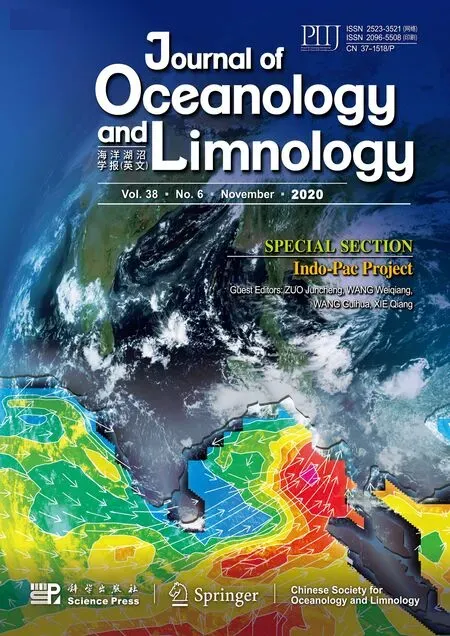 Journal of Oceanology and Limnology2020年6期
Journal of Oceanology and Limnology2020年6期
- Journal of Oceanology and Limnology的其它文章
- Leptolaimus holovachovi sp. nov. (Nematoda) from Shenzhen Mangrove Nature Reserve, Shenzhen, South China*
- Exploring sensitive area in the tropical Indian Ocean for El Niño prediction: implication for targeted observation*
- Analysis of the typhoon wave distribution simulated in WAVEWATCH-III model in the context of Kuroshio and wind-induced current*
- Characterizing the capability of mesoscale eddies to carry drifters in the northwest Pacifi c*
- Observation system simulation experiments using an ensemble-based method in the northeastern South China Sea*
- Statistical analysis of intensity variations in tropical cyclones in the East China Sea passing over the Kuroshio*
